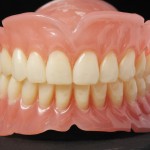
It is widely accepted that the occlusal schemes of complete dentures have a direct influence on their success. A Cochrane review by Sutton et al in 2004 only identified one trial that fully met their inclusion criteria; so recommended further well conducted randomised controlled trials (RCTs). The aim of this review was to assess the evidence on masticatory ability and patient satisfaction with conventional complete dentures of different occlusal designs.
Medline, Embase, and the Cochrane library databases were searched together with the Chinese Biomedical Literature Database (CBM), China National Knowledge Infrastructure (CNKI) and the reference lists of retrieved articles. Hand searches were also conducted in a number of relevant journals. Two reviewers undertook study selection and data abstraction independently. RCTs as well as Prospective studies or retrospective clinical studies were considered.
- 7 RCTs studies met the criteria
- The occlusal designs included; anatomic occlusion, balanced occlusion, canine guidance occlusion, lingualised occlusion, monoplane occlusion, and bilateral-balanced and canine-guided design.
- Because of the heterogeneity and bias of the studies, it was not possible to analyze the data statistically.
- Three of the seven studies showed that lingualised occlusion had ratings of higher patients’ satisfaction than other occlusion designs. On the other hand, the canine-guided occlusion dentures demonstrated equal or better clinical performances than bilateral- balanced dentures.
The authors concluded
Lingualized occlusion and canine-guided occlusion can be successfully applied in the fabrication of complete dentures. Canine guided occlusion has also been shown to be satisfactory. More well-controlled randomized trials are needed regarding canine-guided occlusion and the relationship between alveolar ridge resorption, different occlusal schemes and patient satisfaction. The conventional prosthodontic wisdom that complete dentures require a balanced occlusal design is not supported by the included literature.
Comment
One of the studies included in this review was rejected by the earlier Cochrane review while this study adds 5 newer trials. However the trials are all relatively small, the largest having 45 participants and they have looked at different occlusal schemes. This still means that there is still only a small pool of limited evidence on this question.
Links
Ke Zhao, Qing-Qing Mai, Xiao-Dong Wang, Wen Yang, Li Zhao. Occlusal designs on masticatory ability and patient satisfaction with complete denture: A systematic review. Journal of Dentistry (2013), http://dx.doi.org/10.1016/j.jdent.2013.07.016
Sutton AF, Glenny AM, McCord JF. Interventions for replacing missing teeth: denture chewing surface designs in edentulous people. Cochrane Database of Systematic Reviews 2005, Issue 1. Art. No.: CD004941. DOI: 10.1002/14651858.CD004941.pub2.

super Derek
I also consider lingualised occlusion a realisable category of balanced occlusion. Balanced occlusion is all but impossible to achieve in the laboratory yet alone in vivo. As this review suggests, it is all hocus pocus. Therefore the driver should be dental aesthetics, invariably resulting in anterior guidance